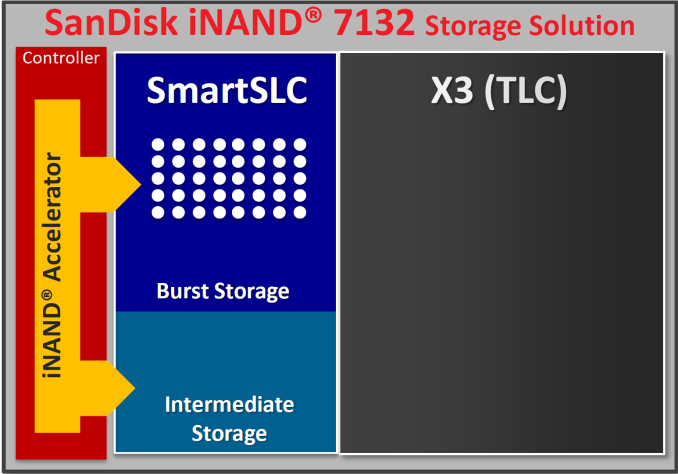SanDisk Announces iNAND 7132: SLC/TLC Hybrid eMMC
by Joshua Ho on March 2, 2015 1:00 AM EST- Posted in
- Smartphones
- SanDisk
- Mobile
- Tablets
- Trade Shows
- MWC 2015

In general, storage performance has been an area that is only discussed when it becomes a bottleneck. There was very little focus on storage performance in general before devices like the original Nexus 7 started experiencing severe performance issues due to IO pauses. However, delivering high performance storage performance has generally limited storage SKUs to 32GB or less, as the cost of such storage is generally difficult to justify otherwise.
This is a problem that SanDisk hopes to solve with their new iNAND 7132, which uses a hybrid SLC/TLC architecture to deliver both high burst performance and cheaper storage for a given design. SanDisk claims that typical storage usage is extremely peaky in nature, even with seemingly contiguous data streams. In addition, relatively few cases can truly saturate modern eMMC on a smartphone even when using a TLC-based solution.
By integrating an SLC cache into the eMMC package, it’s possible to achieve peak sequential reads of up to 280 MB/s, sequential writes of up to 125 MB/s, and up to 2800 and 3300 IOPS for random writes and reads, respectively. Based upon our discussions with SanDisk, it seems that the SLC cache is generally less than a gigabyte, but is usually enough to avoid situations where the SLC cache is filled and writes must go to the TLC storage.
SanDisk has also implemented a great deal of error correction and extensively tested this storage solution, and claims that eMMC solution can last 10 years of 24/7 intense use without data loss. The iNAND 7132 eMMC 5.0 solution is currently available in 16, 32, and 64 GB variants, with a 128GB variant arriving mid-year.











11 Comments
View All Comments
blanarahul - Monday, March 2, 2015 - link
Pretty much.